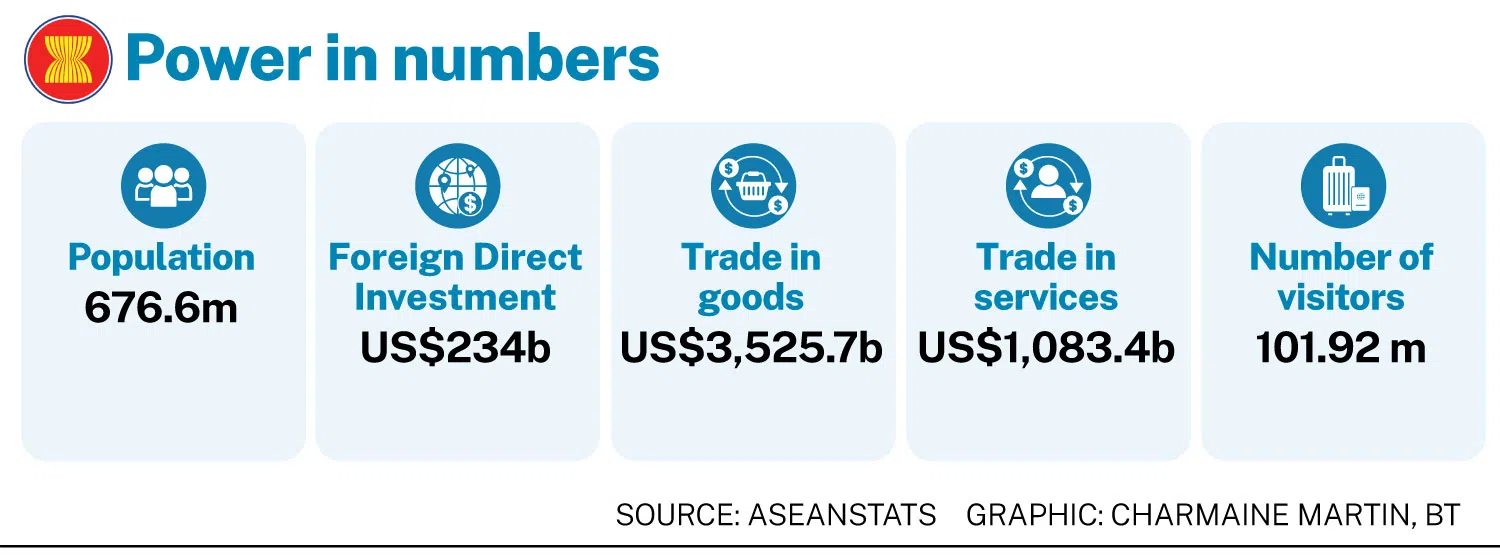No retaliation, but deep concern: Asean decries US tariffs, upholds trade commitments
Economic tsars of the regional bloc vow to uphold trade commitments to keep the region stable and preserve economic ties
[KUALA LUMPUR] South-east Asia’s top economic ministers ruled out retaliation and reaffirmed Asean’s trade commitments, as they sounded the alarm on Washington’s unilateral tariffs, warning that the move threatens to fracture supply chains, unsettle markets and derail the bloc’s economic progress.
In a joint statement after an emergency meeting on Thursday (Apr 10), Asean economic ministers affirmed the bloc’s commitment not to hit back against the US tariffs. Acknowledging the US as Asean’s largest source of foreign investment and second-biggest trading partner, the ministers called for “frank and constructive” talks to prevent a deeper rupture.
The 10-member bloc, representing the fifth-largest economy in the world, also pushed for all parties to explore “mutually acceptable solutions” on issues of common interest.
“These include facilitating two-way trade and investment, deepening strategic trade partnerships, and enhancing supply-chain connectivity and resilience through digital technology and innovation,” they said in a statement after a video meeting among themselves.
This comes as US President Donald Trump said on Wednesday he would temporarily lower the previous steep duties to 10 per cent “for the people who didn’t retaliate”.
His unexpected turnabout took place less than 24 hours after the enforcement of hefty new tariffs, with six of nine South-east Asian countries targeted by the US administration facing steep reciprocal levies of between 32 and 49 per cent.
The 90-day pause on all tariffs – except those targeting China, which were raised to 125 per cent – was announced after Trump claimed that more than 75 countries had reached out to the US to initiate talks on trade barriers.
Following the meeting, Singapore and Malaysia issued separate statements reaffirming Asean’s united stand against retaliation, while stressing the urgent need to deepen intra-regional collaboration to strengthen trade.
Asean’s combined gross domestic product stands at US$3.8 trillion, with the bloc on track to become the world’s fourth-largest economy by 2030. But the current tariff crisis risks slowing that momentum.
SEE ALSO
If Washington sticks to its tariff playbook, it risks unravelling Asean’s decades-long pursuit of economic integration under a rules-based system, Malaysia Trade Minister Tengku Zafrul Aziz warned.
Before tensions flared, the Asian Development Bank had projected Asean’s growth at 4.7 per cent in 2025, led by Vietnam and the Philippines.
Prior to the tariff escalation, Julius Baer analyst Chua Jen-Ai had forecast 2025 GDP growth at 6.7 per cent for Vietnam, 5.9 per cent for the Philippines, and 5 per cent for Indonesia.
Vietnam, one of the bloc’s fastest-growing economies, is aiming even higher. In February, it raised its 2025 growth target to at least 8 per cent, up from the 6.5 to 7 per cent range projected in November, hoping to build enough momentum for sustained double-digit growth from 2026 to 2030.
On Thursday, Hanoi said Washington agreed to initiate trade talks – a crucial development, as failure to reach a deal within the next three months would trigger a punitive 46 per cent levy.
In a statement, Singapore Deputy Prime Minister and Minister for Trade and Industry Gan Kim Yong emphasised the city-state’s commitment to Asean solidarity in the face of rising global uncertainty.
He outlined Singapore’s proactive approach to deepening regional integration, including collaboration with member states to tap into new growth engines such as the digital and green economies, and to expand Asean’s external economic linkages.
Strength in numbers

Asean’s internal market continues to grow. In 2024, total trade in goods reached US$3.5 trillion; intra-Asean trade accounted for a fifth (21.5 per cent) of total regional trade.
Yeah Kim Leng, an economics professor at Sunway University, said the US’ inward pivot presents an opportunity for greater regional collaboration.
He cited the Johor-Singapore Special Economic Zone as a model that could evolve into a broader Asean hub.
“The concept of a special economic zone could be developed into a regional hub to serve the Asean community of nearly 700 million... thereby boosting intra-Asean trade and investment,” he added.
Nazir Razak, chairman of the Asean Business Advisory Council Malaysia Chapter, echoed the sentiment, urging Asean to seize this moment for deeper integration.
“While ‘this is a pivotal time for Asean’ may sound like a cliche... with the world pivoting towards the unknown, it is not,” he said at an event on Tuesday.
“If Asean can’t take large integration steps forward now, if we can’t turbocharge economic integration work streams now, when can we?” he added.
He noted that Asean’s strategic neutrality continues to attract capital from both the East and West. In 2023, foreign direct investment (FDI) into the region hit a record US$234 billion, accounting for 17.2 per cent of global FDI, despite a 10 per cent decline in global FDI inflows.
Citing a recent statement made by the director-general of the World Trade Organization, Tengku Zafrul warned that the escalating trade tensions between the US and China pose a major risk to the global economy’s stability.
A split between the world’s two largest economic blocs could result in a long-term decline of nearly 7 per cent in global real GDP.
Prior to the announcement of the reciprocal tariffs, the World Bank projected global real GDP growth to hold steady at 2.7 per cent in 2025 and 2026.
Decoding Asia newsletter: your guide to navigating Asia in a new global order. Sign up here to get Decoding Asia newsletter. Delivered to your inbox. Free.
Copyright SPH Media. All rights reserved.






